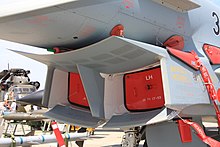Splitter plate (aeronautics)
hideThis article has multiple issues. Please help or discuss these issues on the talk page. (Learn how and when to remove these template messages)
|


A splitter plate is a component in some jet aircraft, used to control the airflow into the engine. Where the engine air intake is mounted partway back along the fuselage or under the wing, the splitter plate diverts the boundary layer away from the engine intake. It is a form of boundary layer control.
Diverting the boundary layer[]
When a body, such as a wing or a fuselage, passes through a fluid such as the air, a boundary layer of fluid attaches to the body and moves along with it. If this layer enters the air intake of a jet engine, it can affect performance.
In order to stop this boundary layer problem from happening, a splitter plate may be used to separate the boundary layer from the fast-moving free airflow and divert it away from the engine intake.
Many splitter plates have a series of holes drilled into the surface closer to the engine side of the intake.[citation needed] Suction is applied to these holes, further reducing the boundary layer.[citation needed]
Aircraft[]
- McDonnell Douglas F-4 Phantom II
- Sukhoi Su-15
- North American XB-70 Valkyrie
- Eurofighter Typhoon
- General Dynamics F-16 Fighting Falcon
- Saab JAS 39 Gripen
- Shenyang J-8
- Chengdu J-10
- Mikoyan Project 1.44
See also[]
- Inlet cone
- Intake ramp
- Diverterless supersonic inlet
- Diffuser (automotive) for automotive splitter plates
References[]
- Hughes, Donald L; Holztman, Jon K; Johnson, Harold J (1972). "Flight-Determined Characteristics of an Air Intake System of an F-111A Airplane" (PDF). Technical Note. NASA. D–6679. Retrieved 15 February 2013.
- Hünecke, Klaus (1997). Jet Engines. England: Airlife. pp. 76–79. ISBN 1853108340.
... the thickening of the boundary layer that develops at high angles-of-attack along the lower side of the fuselage forebody [in the F-16]. In order to prevent low-energy flow from entering the engine, the intake had to be offset from the fuselage to free it from the boundary layer, which uninterruptedly passes along the fuselage. The intake cowl [of the F-16] features a moderately blunt lower lip that transitions into a sharp leading-edge extension or splitter plate on the upper side (close to the fuselage).
- Aircraft propulsion components
- Aircraft component stubs